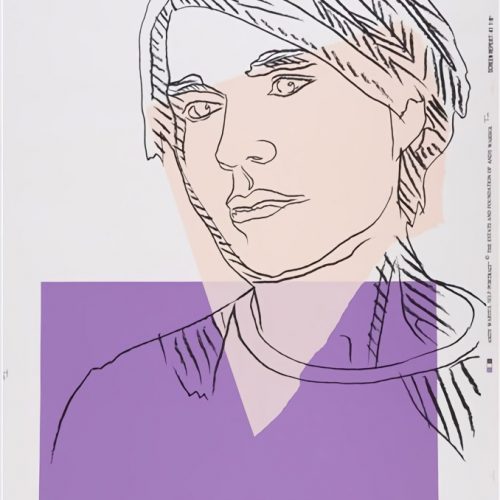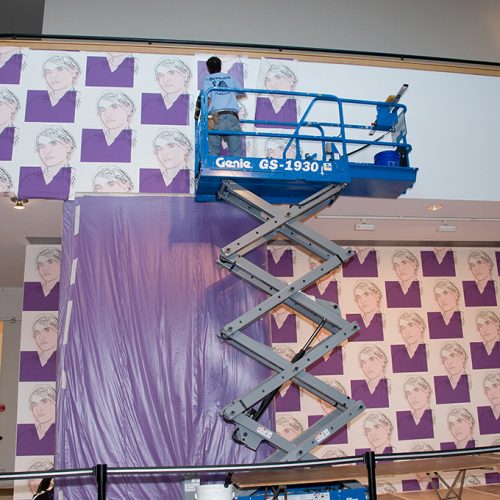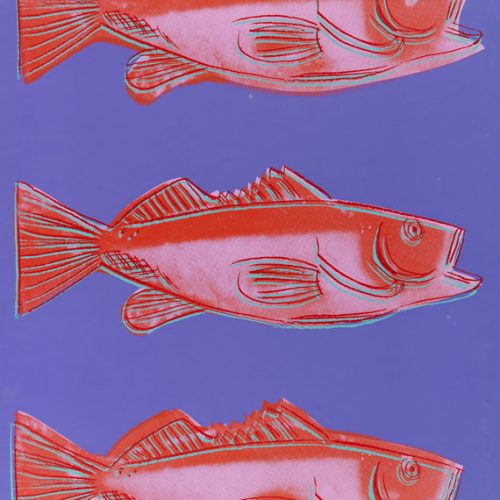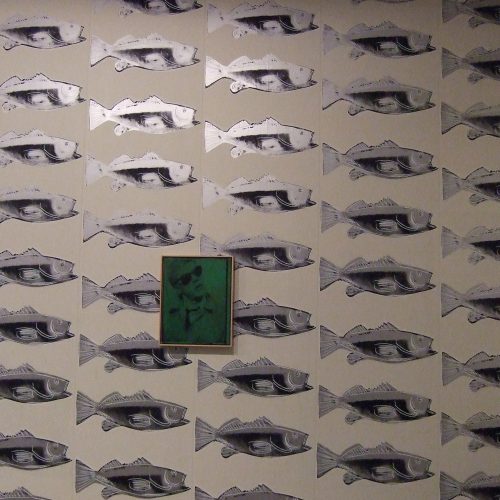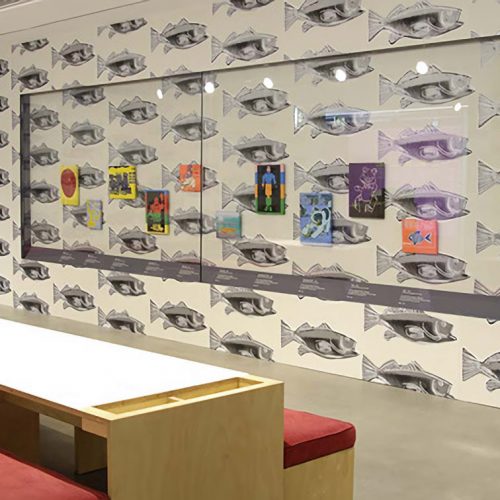ANDY WARHOL
ART AND WALLPAPER – 1963-1983
Paul Maréchal, April 9th, 2020

1. Andy Warhol with Brillo Box and Ruby the cat, 1964. © Billy Name / Reel Art Press.
Andy Warhol (1928-1987) was a pioneer in the creation of artistic wallpapers and produced eight wallpapers during his career, nine in total if we consider the aluminum foil that lined the walls of his first studio, the aptly named Silver Factory (Fig.1). In 1963 Warhol had entrusted the design of the premises to Billy Name (Billy Linich in the city), a lighting designer friend at the theatre who became the official photographer of the Factory throughout the 1960s, who was behind the idea of the aluminum wallpapers.
Two years later, in 1965, a more polished wallpaper concept germinated in Warhol’s mind on the occasion of his very first retrospective exhibition in an American museum, the Institute of Contemporary Arts in Philadelphia. On one of the walls he pasted a hundred of his lithographs of 70 S & H Green Stamps (Fig.2), of which a large part of the 6,000 copy print run had already been folded and mailed as an invitation to the vernissage.
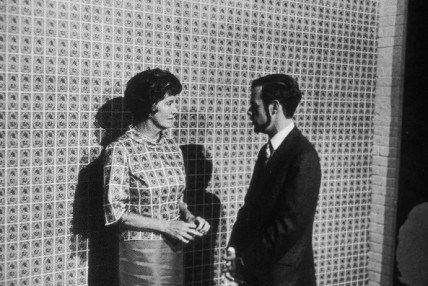
2. S & H Green Stamps, 1965. © Rare Book and Manuscript Library, University of Pennsylvania.
The following year, in 1966, for the exhibition of his work at the Leo Castelli Gallery, Warhol created a real wallpaper, this time featuring a psychedelic-looking cow’s head with its improbable pink head on a bright yellow background that has since become iconic (Fig.3).
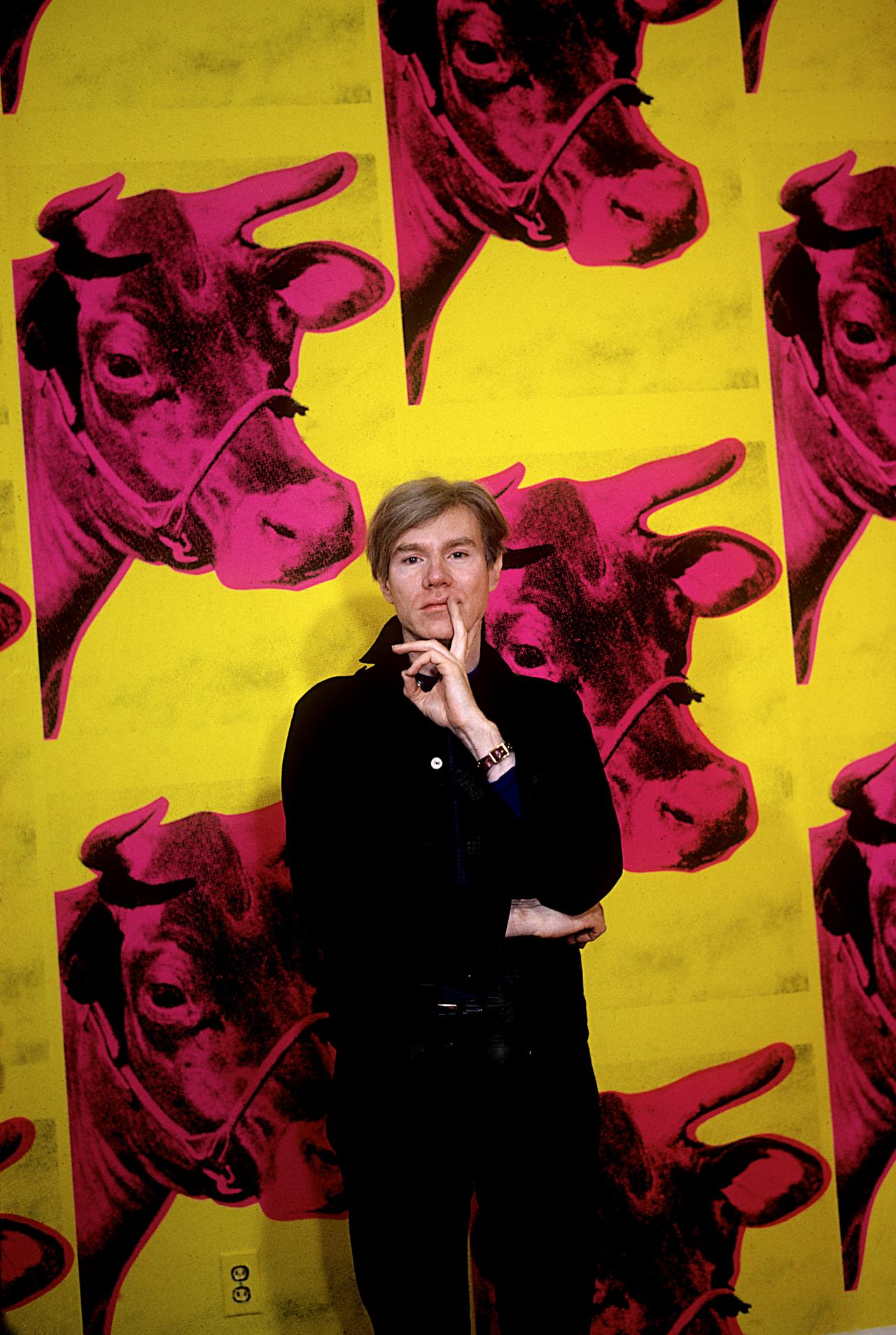
3. Andy Warhol with Cow Wallpaper, 1966, Los Angeles. © Steve Schapiro.
Warhol had found the subject of the cow in a book on agriculture. The bibliographical source of the original black and white picture of the cow that he had used, which he detached from the page, is still unknown to this day.
Warhol’s first three uses of wallpaper were primarily aimed at creating a space, an installation in short, without any work hanging on the wallpaper. Warhol’s idea took a decisive turn five years later, (an idea that he would retain for the rest of his career) when he imagined wallpaper as a background for his paintings. It was at the Whitney Museum in New York, where a retrospective exhibition of his work was held in 1971, that he reused the cow head motif previously designed for the Castelli Gallery. However, this time it was presented in shades of brown against a sky-blue background. Among the paintings he hung on the wallpaper were self-portraits (a form of self-mockery?) and his personal version of the Mona Lisa by Leonardo da Vinci.

4. Cows, 1971. © Warhol Foundation for the visual arts.
Warhol reused the cow motif wallpaper on two further occasions, each time with different color variations, for exhibitions of his work in museums in 1976 and 1979 (Fig. 4).
Warhol’s use of wallpaper as a background for his paintings can be understood as a link between his paintings and their environment – in the manner of a frame – his paintings being mostly unframed or framed in a minimalist way if they were smaller formats. Even more, this presentation of his paintings must be seen as an incursion into designing a total work of art: the work and its environment have both been created by the artist, thus forming a unit.
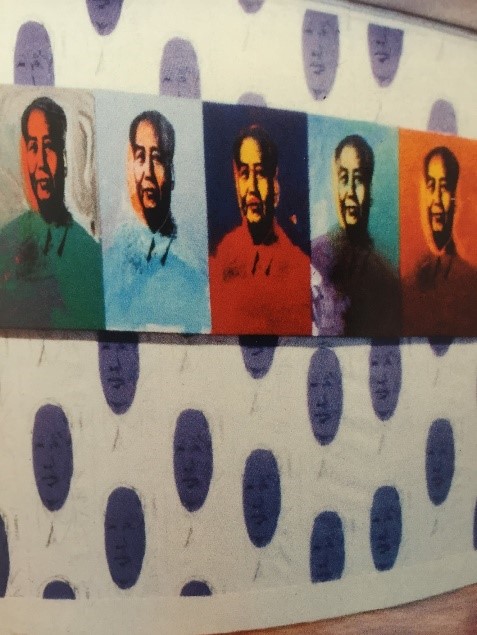
5. Mao, 1972, and Plum Head Mao, 1974.
In 1966, while producing the rock band The Velvet Underground & Nico, Warhol designed the multimedia show Exploding Plastic Inevitable. This total art anthology piece included a projection of pop and psychedelic motifs slides on the walls of the performance hall to the rhythm of the musicians and Nico (the group’s singer), who in turn were accompanied by dancers. This show plunged the audience into an immersive contemporary visual and sound experience never seen before, except since the creation of operas in the 17th century.
Warhol’s wallpapers are always consistent in terms of the motifs represented, namely the multiplication of subjects imitating their multiple state in real life. Be it with the many reflections of the aluminum foil; the multitude of S & H stamps circulating in American homes; the many cows that make up a herd on a farm, Warhol respects this co-existent seriality with the very nature of the subject or object. Only one wallpaper created in 1974 by the artist escapes this observation: representing the American capital’s monument, Washington Monument’s origin and destination remain unknown to this day, having never been used for an exhibition during the artist’s lifetime.
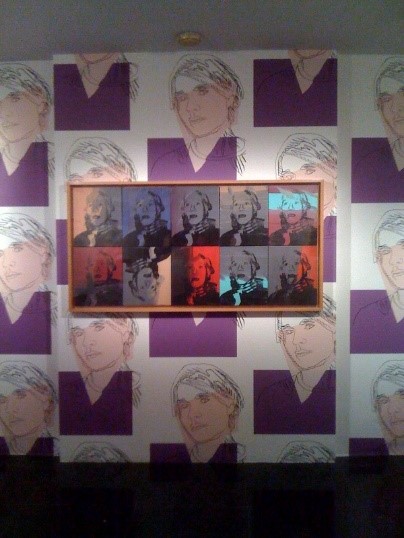
6. Self-Portrait Wallpaper, 1978, and Self-Portrait (Strangulation), 1978. Brooklyn Museum, 2010. © Art Hag.
The fourth wallpaper by Warhol is a freehand drawn portrait of Mao on which he applied a purple oval on his face (also known as the Plum Head Mao). The communist dictatorship’s propaganda had multiplied the image of the famous figure, which he created for the exhibition of his painting series on Mao at the Palais Galliera in Paris in 1974. The Mao portraits were hung on the Mao head motif wallpaper, which resulted in the multiplication of the Great Helmsman’s portraits up to 1,591 copies in this exhibition alone! (Fig. 5).
Warhol’s self-portrait, which generated substantial media attention over the years, was the subject for the artist’s seventh wallpaper in 1978, this time to adorn the walls of both the Kunsthaus in Zurich and the Louisiana in Humblebaek, Denmark, where a selection of his work was presented (Fig.6).
The eighth and final wallpaper designed by Warhol in 1983 is Fish, a fish motif wallpaper that served as a background for his new painting series called Toy Paintings, part of an exhibition he created for children. The small paintings were hung two or three feet from the ground to be at eye level for the little visitors (Fig.7). The exhibition was presented at the Bruno Bischofberger gallery in Zurich and included the sale of a children’s book made of thick cardboard entirely crafted by Warhol.

7. Fish, 1983. CFHILL Art Space, Stockholm.
Serialization, a dominant feature in Warhol’s painted work, presents a repetition of the same image while involving some variations in color or the models’ poses. The wallpaper’s more rigid serialization imposes a static, mechanical and infinitely repetitive vison that Warhol’s paintings animate, and whose serialization is nevertheless changeable.
Warhol’s wallpaper creations are part of a process of developing a multidisciplinary artistic project, which is clearly demonstrated by the artist’s desire not to be perceived or confined to the sole title of painter, but rather as the creator of an art embodied in a large number of media as varied as painting, silkscreen printing, print, photography, film, video, and a variety of media that illustrate the protean work of the King of Pop. Warhol’s work thus becomes Pop in its very essence through its accessibility that went far beyond the fine arts, opening its appreciation and meaning to the greatest number of people, and not only to the regulars in museums and galleries.
Mostly limited to painting, drawing, or sculpture before the Warhol era, artists still walk in the master’s footsteps. Warhol knew better than any other how to show that a multitude of media and supports could better serve creation, and that a medium perceived as commercial, such as wallpaper, could also serve an original artistic project. Most wallpapers created by Warhol have the characteristic of having been designed for exhibitions of his own works. For Warhol, and for some works in particular, the medium was just as important as the work itself, since it was an integral part of it and thus completed its meaning.
PAUL MARÉCHAL
About the author
Montreal native Paul Maréchal is an art historian and the curator of the Power Corporation of Canada collection since 1993. After his undergraduate studies in Cinema and Production at Concordia University in 1988, he pursued a master’s in art history at Université du Québec à Montréal in 1994, where he has taught the course on the art market since 1997.
Paul Maréchal has undertaken extensive studies of Andy Warhol’s work. He is the author of four catalogues raisonnés on the artist’s graphic work. A first survey of all 65 record covers was published by Prestel (Random House’s Art & Architecture subsidiary) in 2008, reissued in 2015. This work served as the basis for the Warhol Live exhibition at the Montreal Museum of Fine Arts in 2008.
In 2014, two additional studies are published by Prestel: the first covered the artist’s 40 advertising posters and the second covered the 425 illustrations and magazine covers commissioned by more than 60 publishers. These publications have been the basis for several exhibitions on these subjects in museums in London, Barcelona, Madrid and Lyon, among others.
Translation by Dominique Robb.
ANDY WARHOL
Silver Factory, 1963
Aluminum paper covering the walls of the Silver Factory
New York
S & H Green Stamps, 1965
Offset lithograph on paper
584 mm x 578 mm (23 in x 22 3/4 in)
Edition of approximately 300
Cow Wallpaper, 1966
Screenprint on wallpaper
1156 mm x 755 mm (45 1/2 in x 29 3/4 in)
Edition of 100, signed
Cows, 1971
Screenprint in colors on wallpaper
1172 mm x 749 mm (46 1/8 in x 29 1/2 in)
Edition of approximately 100 signed impressions
Published by Factory Additions
Washington Monument, 1974
Screenprint on wallpaper
1114 mm × 752 mm (43 9/10 in × 29 3/5 in)
Plum Head Mao, 1974
Screenprint in colors on wallpaper
1018 mm x 755 mm (40 in x 29 3/4 in)
Unnumbered edition of approximately one hundred impressions
Published for the exhibition at the Musée Galliera, Paris, by Factory Additions
Self-Portrait Wallpaper, 1978
Color silkscreen
1040 mm x 765 mm (41 in x 30 in)
Fish, 1983
Color silkscreen
1085 mm x 770 mm (43 in x 30 in)
Published by Feldman / Schellmann
CURATOR
CLAUDE GOSSELIN, C.M. (c.v.)
General and Artistic Director
Centre international d’art contemporain de Montréal
claude.gosselin@ciac.ca
ASSISTANT CURATOR
VINCENT GODIN-FILION
General and Artistic Direction Assistant
Centre international d’art contemporain de Montréal
vincent.godin-filion@ciac.ca




![20004_front_zoomed S&H Green Stamps [II.9], 1965. Offset lithograph on paper
23 x 22 3/4 inches. Edition of approximately 300](http://ciac.ca/wp-content/uploads/2020/04/20004_front_zoomed-500x500.jpg)
![333-201461611551_original Cow [II.11], 1966. Screenprint on wallpaper. 45 1/2 x 29 3/4 inches
Edition of 100, signed.](http://ciac.ca/wp-content/uploads/2020/04/333-201461611551_original-500x500.jpg)
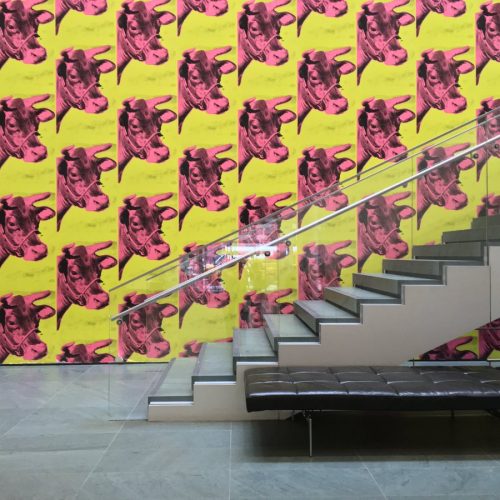
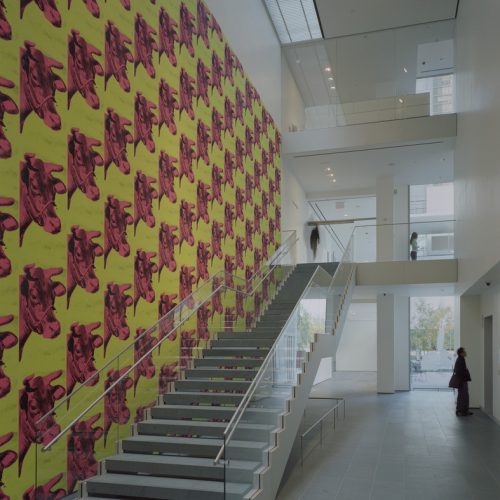


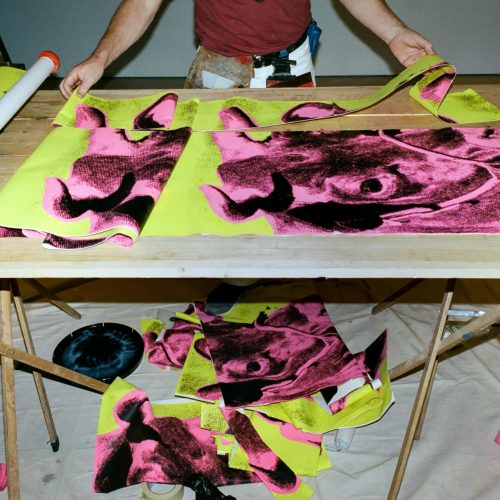
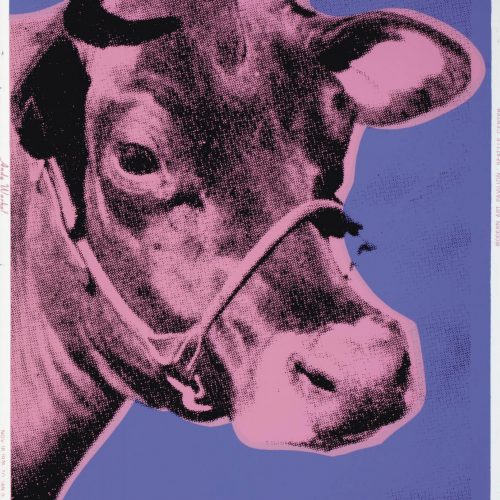

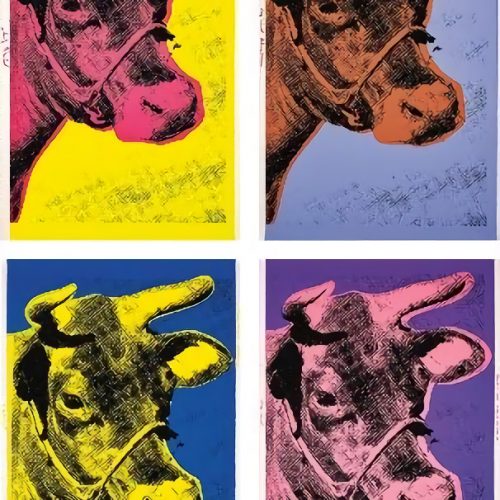
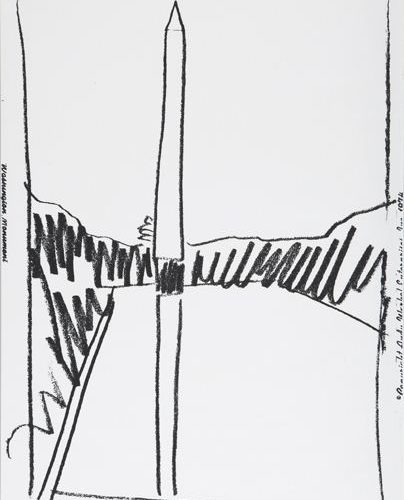
![large_WMAA_WARHOL_33A_SM Installation view of Andy Warhol – From A to B and Back Again (Whitney Museum of American Art, New York, November 12, 2018–March 31, 2019).
From left to right: Factory Diary: Andy Paints Mao, 1972; Vote McGovern, 1972; Mao (Edition 4/300), 1973; Mao (Edition 27/300), 1973; Mao (Edition 32/300), 1973; Mao (Edition 39/300), 1973; Mao (Edition 103/300), 1973; Mao (Edition 204/300), 1973; Mao (Edition 242/300), 1973; Mao (Edition 261/300), 1973; Mao, 1973; Factory Diary: Andy Warhol, Geri Miller, Candy Darling at the Factory, c. 1971–72; Michael Kostiuk, Andy Warhol vacuuming the carpet for an installation piece at Finch College Museum of Art, c. 1972; White Painting [Torso], 1966; Ronald Nameth, Andy Warhol’s Exploding Plastic Inevitable, 1966. Photograph by Ron Amstutz. © 2018 The Andy Warhol Foundation for the Visual Arts, Inc. / Licensed by Artists Rights Society (ARS), New York](http://ciac.ca/wp-content/uploads/2020/04/large_WMAA_WARHOL_33A_SM-500x500.jpg)
![large_WMAA_WARHOL_12_PS-03_SM Installation view of Andy Warhol – From A to B and Back Again (Whitney Museum of American Art, New York, November 12, 2018–March 31, 2019). From left to right: Mylar and Plexiglas Construction, c. 1970; Mao, 1972; Willard Mass, Andy Warhol’s Silver Flotations, 1966; Vote McGovern, 1972; Mao, 1973; White Painting [Torso], 1966. Photograph by Ron Amstutz. © 2018 The Andy Warhol Foundation for the Visual Arts, Inc. / Licensed by Artists Rights Society (ARS), New York](http://ciac.ca/wp-content/uploads/2020/04/large_WMAA_WARHOL_12_PS-03_SM-500x500.jpg)
